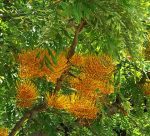 Native to the eastern coast of Australia, this fast growing evergreen tree is also called southern silky oak, silver oak, and Australian silver oak. It is a member of the protea family, Proteaceae, that also includes Banksia and macadamia nut, and not closely related to the true oaks, Quercus. The trees grow up to 150′ tall in the wild but when grown in a pot reaches only 3-10′ . They have dark grey furrowed bark and fern-like leaves that are bipinately divided and have toothed margins. The leaves are 4-12″ long, dark olive green above and silky pubescent below. In early spring 4-12″ long one-sided racemes of yellowish orange to reddish flowers appear on stems that may have lost most of their leaves. The flowers lack petals and consist of a calyx tube that splits into 4 lobes with long styles. Silk tree is a popular shade tree in the tropics and subtropics and can be grown as a houseplant in cooler climates. Flowers attract birds and foliage serves as butterfley larval food. It is brittle in high winds, and has heavy leaf drop in spring with sporadic leaf drop at other times. The genus name, Grevillea, honors Charles Francis Greville (1749-1809) founder of the horticultural Society of London. The specific epithet, robusta, is the Latin word meaning strong and refers to the wood of the plant. Type: Evergreen tree
Native to the eastern coast of Australia, this fast growing evergreen tree is also called southern silky oak, silver oak, and Australian silver oak. It is a member of the protea family, Proteaceae, that also includes Banksia and macadamia nut, and not closely related to the true oaks, Quercus. The trees grow up to 150′ tall in the wild but when grown in a pot reaches only 3-10′ . They have dark grey furrowed bark and fern-like leaves that are bipinately divided and have toothed margins. The leaves are 4-12″ long, dark olive green above and silky pubescent below. In early spring 4-12″ long one-sided racemes of yellowish orange to reddish flowers appear on stems that may have lost most of their leaves. The flowers lack petals and consist of a calyx tube that splits into 4 lobes with long styles. Silk tree is a popular shade tree in the tropics and subtropics and can be grown as a houseplant in cooler climates. Flowers attract birds and foliage serves as butterfley larval food. It is brittle in high winds, and has heavy leaf drop in spring with sporadic leaf drop at other times. The genus name, Grevillea, honors Charles Francis Greville (1749-1809) founder of the horticultural Society of London. The specific epithet, robusta, is the Latin word meaning strong and refers to the wood of the plant. Type: Evergreen tree
Outstanding Feature: Foliage and flowers
Form:Pyramidal when young; conical to rounded as it matures
Growth Rate: Rapid
Bloom: Clusters of yellowish orange to reddish flowers in spring
Size: Up to 150′ in natural habitat, 3-10′ in pot
Light: Full sun
Soil: Average to lean, moderately moist, well-drained, slightly acidic; drought resistant when established
Hardiness: Zones 10-12; semi-deciduous in 8-9
Care: Clean up leaf litter as it falls
Pests and Diseases: Susceptible to scale, Phytophthora and root rot.
Propagation: Seed. semi hardwood cuttings, grafts
Photo Credit: Alvesgaspar, Wikipedia